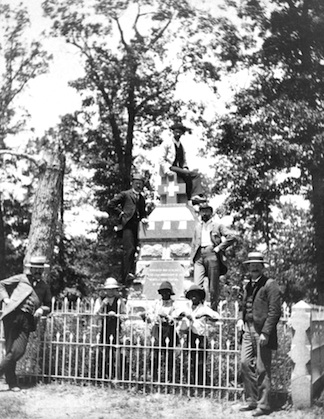Shaping Chancellorsville: The first memory memorialized on the field
part two in a series
 The first effort to mark out events on the Chancellorsville Battlefield came as early at 1883, although some accounts suggest it happened as early as 1876. Former members of Stonewall Jackson’s staff placed a large quartz boulder along the Orange Plank Road to mark the area where Jackson had been accidentally wounded. The “Jackson Rock,” as it has become known, sits in the same area today; it is the oldest marker on the Chancellorsville battlefield and, if the earlier date holds true, the oldest marker in the entire park.[1]
The first effort to mark out events on the Chancellorsville Battlefield came as early at 1883, although some accounts suggest it happened as early as 1876. Former members of Stonewall Jackson’s staff placed a large quartz boulder along the Orange Plank Road to mark the area where Jackson had been accidentally wounded. The “Jackson Rock,” as it has become known, sits in the same area today; it is the oldest marker on the Chancellorsville battlefield and, if the earlier date holds true, the oldest marker in the entire park.[1]
In 1888, a local committee decided to erect a formal monument to Jackson in the same area.
James Power Smith, one of Jackson’s former staff officers and a local Presbyterian minister, who had been involved with the placement of the Jackson Rock, chose a 1.5-acre plot of land donated by William N. Wyeth, next to the Plank Road. Smith again affirmed the decision to mark the area of Jackson’s wounding, not the specific spot, because the committee wanted the monument to be visible from the road by passing tourists.[2] “When we were selecting a location for the monument,” Smith wrote in a 1905, “the present site was selected, as being on the [Orange Plank] road—somewhat elevated—and as being a fair compromise…. It is only a few rods from the exact spot wherever that was.”[3]
 Dedication of the monument, on June 13, 1888, drew spectators from across the state, including Governor Fitzhugh Lee. During the battle, Lee had served as a cavalry scout, and at the ceremony he recounted part of those exploits. “Ah, I remember well that day,” he said. One of the veterans in attendance yelled back, “So do I, General!” eliciting much amusement from the crowd.[4]
Dedication of the monument, on June 13, 1888, drew spectators from across the state, including Governor Fitzhugh Lee. During the battle, Lee had served as a cavalry scout, and at the ceremony he recounted part of those exploits. “Ah, I remember well that day,” he said. One of the veterans in attendance yelled back, “So do I, General!” eliciting much amusement from the crowd.[4]
Note, then, that the first piece of ground set aside at Chancellorsville was dedicated to commemorating the martyrdom of Jackson.  However, the Reconciliation memory played an important role: the idea for the memorial first came up the year before at the dedication of a memorial to fallen Federal Sixth Corps commander Major General John Sedgwick at Spotsylvania Court House. A vast crowd, including veterans from both sides, assembled in common good spirit for the dedication of the Sedgwick monument, and only then did the local Confederate veterans realize they were late to the memorialization party for fallen heroes.
However, the Reconciliation memory played an important role: the idea for the memorial first came up the year before at the dedication of a memorial to fallen Federal Sixth Corps commander Major General John Sedgwick at Spotsylvania Court House. A vast crowd, including veterans from both sides, assembled in common good spirit for the dedication of the Sedgwick monument, and only then did the local Confederate veterans realize they were late to the memorialization party for fallen heroes.
“What hearts these northern men have that they come all the way down here to do this for their general!” said Confederate veteran John Lewis, speaking at the Sedgwick monument’s dedication. “I honor them for this. What hearts they have! How they stand by their hero! How they remember him! How they care for his glory! But we—yes, we have given up Jackson.”[5]
Jackson would not stay “given up” for long. In fact, as we’ll see later in the series, the battlefield hasn’t given him up yet.
[1] Pfanz. Donald C. History Through the Eyes of Stone: A Survey of Civil War Monuments Near Fredericksburg, Virginia. Fredericksburg & Spotsylvania National Military Park (FSNMP), 2006. pg. 122.
[2] Mink, Eric J. “Southern Exposure: Dedication of the Stonewall Jackson Monument at Chancellorsville.” Frederickburg History & Biography, 2006. pp. 124-127.
[3] Smith, James P. April 27, 1905, letter to Mr. Stuart. FSNMP collection. Ms. 03001, BV 268.
[4] Pfanz, 129.
[5] Ibid, 126.